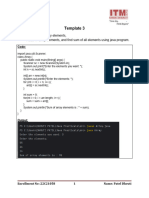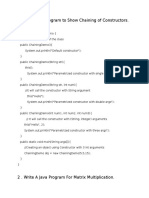0% found this document useful (0 votes)
9 views9 pagesJavaRec CO1 2024
The document outlines a series of programming exercises focused on object-oriented concepts in Java, including class definitions, constructors, and method overloading. It includes tasks such as creating a product class to find the lowest priced item, performing matrix addition, adding complex numbers, checking matrix symmetry, and implementing a CPU class with nested classes for Processor and RAM. Each task is accompanied by sample code and expected outputs to guide understanding and implementation.
Uploaded by
pssafvan97Copyright
© © All Rights Reserved
We take content rights seriously. If you suspect this is your content, claim it here.
Available Formats
Download as PDF, TXT or read online on Scribd
0% found this document useful (0 votes)
9 views9 pagesJavaRec CO1 2024
The document outlines a series of programming exercises focused on object-oriented concepts in Java, including class definitions, constructors, and method overloading. It includes tasks such as creating a product class to find the lowest priced item, performing matrix addition, adding complex numbers, checking matrix symmetry, and implementing a CPU class with nested classes for Processor and RAM. Each task is accompanied by sample code and expected outputs to guide understanding and implementation.
Uploaded by
pssafvan97Copyright
© © All Rights Reserved
We take content rights seriously. If you suspect this is your content, claim it here.
Available Formats
Download as PDF, TXT or read online on Scribd
/ 9




























































































